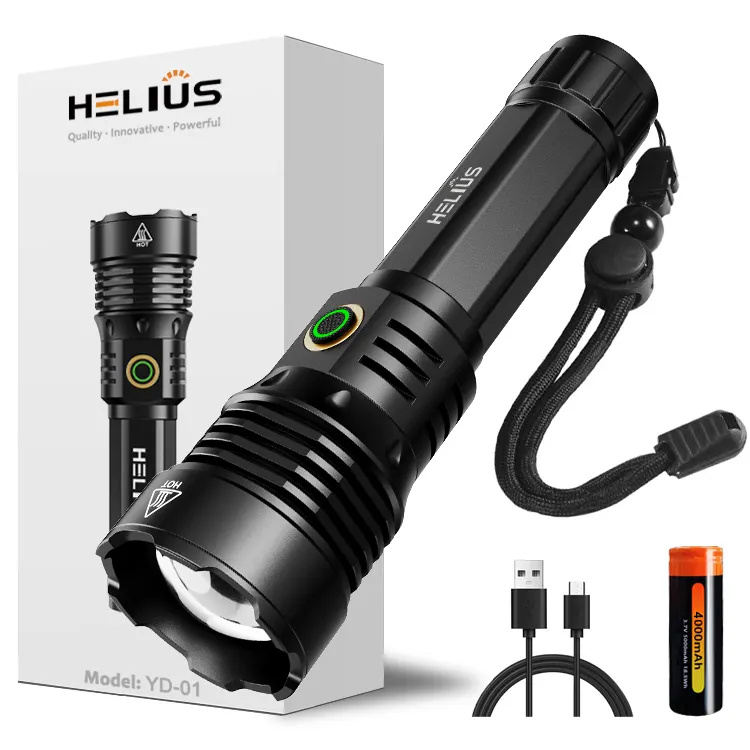Flashlight Inventory Management: Best Practices for Business Owners

Effective inventory management is essential for flashlight businesses aiming to boost profitability and streamline operations, as highlighted in 'Flashlight Inventory Management: Best Practices for Business Owners.' Poor management can lead to overstocking, tying up resources, or understocking, resulting in lost sales. Common challenges include managing defective items, predicting demand, and handling complex supply chains. For example, reducing out-of-stock rates by just 1% can increase sales by 2-4%. By adopting inventory best practices, such as maintaining accurate data and balancing stock levels, you can reduce costs and improve efficiency. These strategies ensure your flashlight inventory management system supports long-term success.
Key Takeaways
Know what your business needs by checking stock size and sales speed. This helps keep the right amount of items and avoids having too much or too little.
Pick the best way to manage stock, like Just-in-Time (JIT) or Economic Order Quantity (EOQ). Choose based on your goals to save money and work better.
Use tools like barcodes and RFID to track stock instantly. This makes tracking more accurate and reduces mistakes.
Check your stock often to find problems and stop losses. This keeps your inventory correct and well-managed.
Change your stock plans based on trends and what customers like. Staying updated helps you meet new needs and stay ahead.
Identifying the Right Inventory Management Approach
Understanding Business Needs
Assessing inventory scale, turnover rates, and seasonal demand.
Understanding your business needs is the first step in effective inventory management. Start by evaluating the scale of your inventory. Determine how much stock you need to maintain based on your sales volume and storage capacity. High turnover rates indicate strong demand, while low turnover suggests overstocking or slow-moving items. Seasonal demand also plays a critical role. For instance, flashlights may see higher demand during winter months or emergency seasons. Adjust your inventory levels accordingly to avoid shortages or excess stock.
Identifying slow-moving and high-demand flashlight models.
Identifying which flashlight models sell quickly and which do not is essential. High-demand models should always be in stock to meet customer needs. On the other hand, slow-moving items tie up capital and occupy valuable storage space. Use data from past sales to pinpoint these trends. Regularly review your inventory to optimize stock levels and focus on products that drive revenue.
Selecting an Inventory Management Method
Comparing Just-in-Time (JIT) and Economic Order Quantity (EOQ).
Choosing the right inventory management method depends on your business goals. Just-in-Time (JIT) inventory management minimizes holding costs by ordering stock only when needed. This approach works well for businesses with reliable suppliers but can be risky during supply chain disruptions. Economic Order Quantity (EOQ), on the other hand, calculates the optimal order quantity to minimize total costs, including ordering and holding expenses. EOQ suits businesses aiming for a balance between cost efficiency and stock availability.
Evaluating manual versus automated inventory systems.
Deciding between a manual or automated system impacts your inventory efficiency. Manual systems require significant time and effort, often leading to errors and delays. For example, tracking inventory manually can detract from other critical tasks like marketing or customer service. Automated systems, however, use tools like barcodes and QR codes for real-time updates. These systems improve accuracy and save time, making them ideal for businesses looking to scale operations. Implementing an automated system ensures your inventory data remains accurate and up-to-date.
Implementing Inventory Tracking and Control Systems

Leveraging Technology for Inventory Control
Using barcoding and RFID for real-time tracking.
Technology plays a vital role in modern inventory control. Barcoding and RFID systems allow you to track inventory in real time, ensuring accurate stock levels. RFID technology, in particular, provides several advantages. It enables you to monitor inventory movements instantly, reducing errors and improving efficiency. Integration with cloud services enhances cybersecurity and ensures smooth operations. Continuous updates in RFID technology keep your business competitive in a fast-changing market. Additionally, robotics and autonomous systems can further improve speed and accuracy in your warehouse operations. These advancements make inventory tracking more reliable and less time-consuming.
Integrating inventory management software with POS systems.
Integrating inventory management software with your POS system streamlines operations and enhances inventory control. This integration offers real-time inventory tracking, helping you maintain accurate stock levels and avoid overstock or stockout situations. It also improves customer service by providing sales staff with up-to-date product availability, which reduces wait times and enhances customer interactions. Automated inventory tasks reduce human error, allowing your team to focus on other critical areas of your business. Mobile applications linked to these systems let you monitor inventory levels and shipments remotely, ensuring you stay informed at all times.
Establishing Inventory Control Processes
Setting reorder points based on sales data analysis.
Setting reorder points is essential for effective inventory control. Start by analyzing demand patterns over time to understand customer needs. Calculate lead times accurately, including a buffer for unexpected delays, to prevent stockouts. Safety stock acts as a cushion against demand spikes or supply chain disruptions. Balancing holding and ordering costs is crucial, and using Economic Order Quantity (EOQ) models can help. Regularly review your inventory to ensure reorder points remain effective and responsive to market changes. Continuous improvement in this process allows you to adapt to evolving business needs.
Categorizing inventory using ABC analysis.
ABC analysis helps you prioritize inventory management efforts by categorizing items into three classes: A, B, and C. Category A includes high-value items that require close monitoring, while Categories B and C consist of less critical items needing less frequent oversight. This method improves inventory optimization and forecasting. It also supports better pricing strategies, informed supplier negotiations, and strategic resource allocation. By focusing on high-value items, you can enhance customer service and reduce storage expenses. ABC analysis ensures your inventory control processes remain efficient and aligned with your business goals.
Conducting Regular Stock Audits and Quality Checks
Importance of Stock Audits
Identifying discrepancies and ensuring accountability.
Regular stock counts are essential for maintaining accurate inventory control. Discrepancies often arise from mismatched inventory counts, misplaced items, or shipping errors. These issues can disrupt your operations and lead to financial losses. Conducting physical inventory checks helps you identify and resolve these problems. For example, you can catch errors in receiving goods or incorrect tracking before they escalate. Implementing advanced systems like barcode scanning or RFID technology ensures real-time updates, reducing the chances of errors. Regular audits also promote accountability among your team, ensuring everyone follows proper inventory management practices.
Preventing theft, loss, or mismanagement.
Inventory shrinkage, caused by theft or damage, can significantly impact your bottom line. Regular stock counts allow you to detect and address these issues promptly. Training your staff on proper inventory handling minimizes errors and reduces the risk of mismanagement. Investing in warehouse management software enhances inventory control by providing real-time visibility into stock movements. Monitoring sales trends and optimizing procurement processes prevent overstocking, which can lead to unnecessary losses. By staying proactive, you can safeguard your inventory and maintain operational efficiency.
Ensuring Product Quality
Inspecting flashlights for defects and damage.
Maintaining product quality is crucial for customer satisfaction and brand reputation. Inspect your flashlights regularly to identify defects or damage. Damaged products not only lead to returns but also harm your credibility. Establish stringent quality control measures during receiving and storage. For instance, using cycle counts ensures you catch issues early and maintain consistent quality standards. Incorporating technology like RFID systems streamlines inspections and improves accuracy. A focus on quality helps you build trust with your customers and ensures your inventory remains sellable.
Implementing a First-In, First-Out (FIFO) approach.
The FIFO approach is a simple yet effective inventory management strategy. It ensures older stock is sold first, reducing the risk of holding unsellable inventory. This method aligns inventory flow with sales orders, helping you maintain accurate stock values. FIFO also minimizes the impact of inflation by selling older, cheaper stock first. By adopting this approach, you can optimize operations and reduce holding costs. It also simplifies inventory control, making it easier to monitor quality and maintain profitability. Implementing FIFO ensures your inventory management system remains efficient and customer-focused.
Optimizing Inventory Levels Through Forecasting and Data Analysis

Using Historical Data for Forecasting
Analyzing past sales trends to predict future demand.
Analyzing historical sales data is essential for effective inventory management. By studying past trends, you can identify patterns that help predict future demand. For example, time series analysis allows you to account for seasonal factors, ensuring your stock levels align with customer needs. Regression analysis can also provide insights into how external factors, like promotions or weather, influence demand. These techniques help you maintain the right inventory, reducing the risk of overstock or stockouts.
Demand forecasting ensures that the right products are available at the right time. This minimizes excess inventory and improves inventory control. By leveraging statistical models, you can make informed decisions about when to replenish stock. This approach not only optimizes inventory levels but also enhances customer satisfaction by ensuring product availability.
Identifying peak seasons and slow periods.
Understanding peak seasons and slow periods is critical for maintaining balanced stock levels. Flashlights, for instance, may experience higher demand during winter or emergency seasons. Analyzing historical data helps you identify these trends and adjust your inventory accordingly. During peak seasons, you can increase stock to meet demand. In slower periods, reducing inventory prevents overstock and minimizes holding costs.
Using causal models, you can identify factors that drive demand during specific times. This allows you to plan inventory management strategies that align with market trends. By staying proactive, you can avoid disruptions and maintain efficient inventory control throughout the year.
Implementing Demand Planning Strategies
Collaborating with sales and marketing teams for accurate forecasts.
Collaboration with sales and marketing teams improves the accuracy of your inventory forecasts. Sales teams provide insights into customer trends, while marketing teams share information about upcoming campaigns that may influence demand. Regular cross-functional meetings ensure alignment on inventory needs and strategies.
Sharing data across departments enhances inventory control by creating a unified approach to demand planning. Predictive analytics tools further improve forecast accuracy, helping you maintain optimal stock levels. This collaboration ensures your inventory management system remains responsive to market changes.
Adjusting inventory levels based on market trends.
Market trends play a significant role in inventory management. By monitoring industry developments and customer preferences, you can adjust inventory levels to meet changing demands. For instance, integrating ERP systems with sales data provides real-time insights into inventory performance. This allows you to make data-driven decisions about stock replenishment.
Continuous improvement processes, such as auditing inventory performance metrics, help you refine your strategies. Striving for consensus forecasts ensures your inventory aligns with market needs. By staying adaptable, you can optimize inventory control and maintain profitability in a dynamic market.
Managing Supplier Relationships and Ensuring Product Quality
Building Strong Supplier Partnerships
Negotiating favorable terms and lead times.
Negotiating with suppliers is a critical part of inventory management. To secure favorable terms, you need to prepare thoroughly. Research market rates and compare vendor competition. Understand your business needs and set a clear budget. Build strong relationships with suppliers by fostering mutual respect. Group related items together when negotiating to achieve better deals. These steps help you reduce costs and improve inventory control.
Maintaining open communication for timely deliveries.
Open communication with suppliers ensures smooth operations. Clear expectations prevent delays and keep your stock levels consistent. Regular updates allow you to address issues quickly. For example, if a shipment faces delays, prompt communication helps you find alternative solutions. A collaborative environment encourages suppliers to share concerns, leading to faster problem-solving. This approach strengthens supplier relationships and ensures your inventory remains reliable.
Ensuring Consistent Product Quality
Setting quality standards and conducting supplier audits.
Maintaining product quality starts with setting clear standards. Share these expectations with your suppliers to ensure alignment. Conduct regular supplier audits to verify adherence to these standards. Audits also help you detect potential issues early. Before an audit, review the supplier’s reputation and analyze customer complaints. Prepare a checklist to keep the process focused. These practices build trust with trustworthy suppliers and ensure your inventory meets customer expectations.
Establishing contingency plans for supplier issues.
Supplier disruptions can impact your inventory management. Establish contingency plans to address these challenges effectively. Use tracking systems to monitor shipments in real time and prevent cargo loss. Set KPIs to evaluate the effectiveness of your contingency measures. Data reporting tools help you identify bottlenecks and respond proactively. These strategies ensure your inventory control processes remain resilient, even during unexpected disruptions.
Planning for Growth and Adapting to Market Trends
Scaling Inventory Management Systems
Upgrading systems to handle increased inventory volumes.
As your business grows, your inventory systems must scale to meet higher demands. Upgrading these systems ensures you can handle increased inventory volumes without compromising efficiency. A scalable system offers several benefits:
Anticipate Customer Needs: Predict demand accurately to maintain appropriate stock levels.
Optimize Inventory Levels: Avoid overstocking or understocking by using precise forecasts.
Centralized Order Management: Manage orders from multiple channels in one place, improving customer experience.
Efficient Order Processing: Streamline processes to reduce errors and speed up deliveries.
Real-Time Inventory Accuracy: Update stock levels across all channels instantly to prevent overselling.
Growth Readiness: Adapt to business expansion without overhauling your system.
Investing in a flexible and scalable inventory management system reduces long-term costs and prepares your business for future growth.
Training staff to manage larger operations.
Your team plays a critical role in managing larger inventory operations. Proper training ensures they can handle the complexities of a growing business. Follow these steps to train your staff effectively:
Identify the skills your team needs and assess their current abilities.
Choose a training model that aligns with your business goals.
Use real-world scenarios to make learning practical and relatable.
Evaluate the training program regularly and adjust as needed.
Encourage continuous learning to keep skills updated.
Well-trained staff improve inventory accuracy and streamline operations, ensuring your inventory management system runs smoothly.
Staying Ahead of Market Trends
Monitoring industry developments and customer preferences.
Staying informed about market trends helps you adapt your inventory strategies. The flashlight market is evolving rapidly due to advancements in technology and shifting consumer preferences. LED technology and rechargeable flashlights are becoming increasingly popular. Customers also prefer eco-friendly options, reflecting a growing demand for sustainable products. The market is projected to grow at a compound annual growth rate (CAGR) of 6.43% from 2024 to 2031, reaching USD 15.54 billion by 2031. Monitoring these trends allows you to align your inventory with customer expectations and industry standards.
Adapting inventory strategies to meet changing demands.
Adapting your inventory strategies ensures you stay competitive in a dynamic market. Implement these practices to meet changing demands:
Maintain strong supplier relationships to secure timely deliveries.
Use demand forecasting to predict future needs based on historical data.
Optimize SKU rationalization by evaluating product performance.
Streamline supply chain processes to reduce lead times and costs.
Monitor inventory turnover to identify slow-moving items.
These strategies help you manage inventory effectively, reduce risks, and respond quickly to market fluctuations.
Adopting best practices in flashlight inventory management ensures your business operates efficiently and profitably. These practices optimize inventory costs, provide actionable data, and improve customer service by maintaining sufficient stock levels. Leveraging technology, such as inventory management software, enhances real-time visibility and streamlines operations. Regular audits and supplier collaboration further strengthen your management processes.
To implement these strategies effectively, focus on proven methods like FIFO, regular audits, and supplier relationship management. These steps reduce losses, improve accuracy, and ensure stable supply. By planning for growth and adapting to market trends, you position your business for long-term success.
FAQ
What is the best way to track flashlight inventory in real time?
Using inventory management software integrated with barcoding or RFID technology provides real-time tracking. These tools update stock levels instantly, helping you avoid overstocking or stockouts. They also reduce manual errors and improve operational efficiency.
How often should I conduct stock audits for my flashlight inventory?
Conduct stock audits at least quarterly to maintain accuracy. For high-demand or high-value items, consider monthly audits. Regular checks help you identify discrepancies, prevent losses, and ensure accountability among your team.
How can I predict seasonal demand for flashlights?
Analyze historical sales data to identify patterns. Look for trends during specific seasons, such as winter or emergency periods. Collaborate with your sales and marketing teams to refine forecasts and adjust inventory levels accordingly.
What should I do with slow-moving flashlight models?
Identify slow-moving models using sales data. Offer discounts or bundle them with high-demand items to clear excess stock. Focus on optimizing your inventory by prioritizing products that generate consistent revenue.
How do I ensure my suppliers deliver quality flashlights?
Set clear quality standards and share them with your suppliers. Conduct regular audits to verify compliance. Maintain open communication to address issues promptly. Establish contingency plans to handle supplier disruptions effectively.
See Also
Proven Marketing Approaches for Your Flashlight Wholesale Venture
Essential Advice for Procuring Wholesale Flashlights Effectively
Mastering Quality Assurance in Your Flashlight Wholesale Orders
Boosting Revenue by Sourcing Flashlights from Wholesale Vendors
